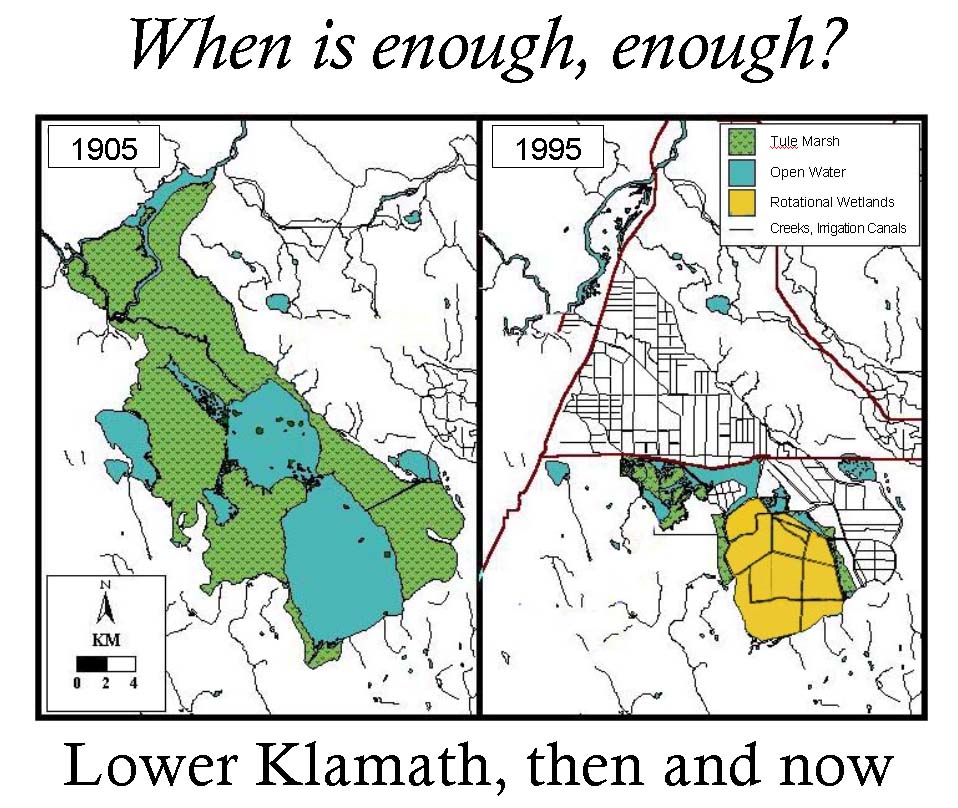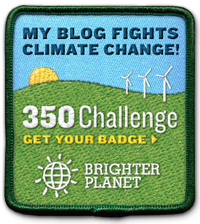
This choice to divert water was prompted by the fact that the area supports an endangered species of fish - the shortnosed suckerfish. It is also a critical stop on the pacific flyway and supports large numbers of migrating birds, namely Bald Eages and is an important ground for American White Pelicans. The farmers were outraged that their crops were being threatened to protect a suckerfish, so they turned to illegal means to get their water. Opening floodwalls that were diverting the water to allow it to drain into their irrigation canals.

The local police were not willing to do anything about these actions because they sided with the farmers.
The bullet points below are an excerpt from this website: http://www.klamathbasin.info/2003costs.pdf

Lower Klamath, Tule Lake, and Clear Lake National Wildlife Refuges Impacts
• The 2003 plan estimates–but does not guarantee–a 22,000 acre-feet water delivery to Lower Klamath and Tule Lake refuges. This represents the smallest water delivery to the refuges in 41 years.
• U. S. Fish and Wildlife Service documents indicate 2002 was the sixth year out of the last 13 when the refuges received no water in the fall, when peak waterfowl migration occurs. The 2003 plan almost guarantees a seventh year of dry refuges. This chronic lack of water degrades marsh habitat, disrupts waterfowl migration, and reduces the food supply for threatened bald eagles.
• The Upper Klamath Basin supports the largest seasonal concentration of bald eagles in the Lower 48 states, and Tule Lake and Lower Klamath refuges contain much of the key wintering habitat for these eagles (Keister et al., 1987). The 2003 plan supplies 10,000 acre-feet less water than required in 2001 to prevent a die-off of bald eagles.
• The 2003 plan threatens California’s only remaining breeding colonies of American white pelicans, and two of the last fifteen colonies remaining in the world, located within Lower Klamath and Clear Lake refuges. Low water levels expose pelican nesting islands to predators, which can cause the mass desertion of nests and young. According to the California Department of Fish and Game, destruction of nesting islands and breeding habitat has caused a precipitous decline in pelican numbers. As of early April, three of Clear Lake’s four pelican nesting islands were already land-bridged by low water levels and unsuitable for nesting.
• Combating avian botulism–a disease that can kill thousands of birds on the refuge in a single outbreak–requires the ability to alternatively flood or drain different parts of the refuge. Refuge water shortages insure the increased prevalence of botulism by preventing essential water management.

Upper Klamath Lake and Upper Klamath National Wildlife Refuge Impacts
• The 2003 plan will eliminate the lake’s marsh habitat–essential to both endangered fish and migratory waterfowl–for four solid months. The plan calls for lowering Upper Klamath Lake water levels below 4140 feet in elevation from August through December, and for levels at or below 4139 feet from August through November. When the lake falls below 4140 feet, bordering marshes start going dry. Roughly half of the lake’s marshes will have no water at 4139.5 feet. Below 4193 feet, all of Upper Klamath Lake’s marshes will be completely dry. Under the plan, all 14,400 acres of Upper Klamath
• Development of Water Supply Production Wells for Lower Klamath NWR, Final EA, USFWS 2001, p. 26 refuge marshes will remain dry from August through November, leaving thousands of acres of critical refuge wetlands dry during the fall migration of waterfowl and other birds. Other marshes left dry by the plan include the Klamath Game Management areas at Squaw Point, Shoalwater Bay, and marsh restoration projects along the lake.
• The plan’s low lake levels will increase the likelihood of algae blooms and related mass die-offs of endangered suckers in the late summer and early fall. Higher water levels can decrease the duration and intensity of such algae blooms (Laenen and LeTourneau 1996; Noges et al, 1997; Welch and Burke 2001; Sheffer 1998), thereby minimizing the likelihood of a recurrence of the devastating adult fish kills observed in 1995, 1996, and 1997.
• Lowered lake levels will cut off suckers from essential spawning habitat around the lake. Loss of spawning grounds is one of the principle factors in the decline of the lake’s sucker populations. Lowered levels will also cut off access to the cool, clear waters of lakeside springs and creeks, where fish often take refuge from the lake’s often lethal water quality conditions.
• The lake’s wetland areas provide critical safe havens for young Lost River and shortnosed suckers, which use marshes to escape predators. The dramatic, long-term loss of marsh habitat under the Bureau’s plan will greatly reduce their chances for survival, and impact sucker populations for generations to come.
• The plan’s long-term low lake levels will worsen Upper Klamath Lake’s already extreme water quality problems. Leaving the marshes dry from August through November will eliminate the positive water-filtering function of the lake’s bordering wetlands. In addition, chronically dry marshes may become a source of poor water quality: exposed marsh peat soils can oxidize, releasing nitrogen and phosphorous. When water finally returns to the marshes, these pollutants wash into the lake and increase water quality problems.



1 comment:
seen this?
http://www.amazon.com/Water-War-Klamath-Basin-Politics/dp/159726394X/ref=sr_1_11?ie=UTF8&s=books&qid=1217292780&sr=8-11
Post a Comment